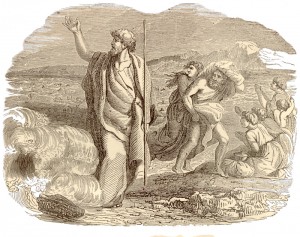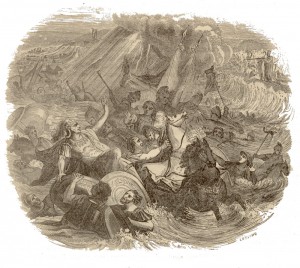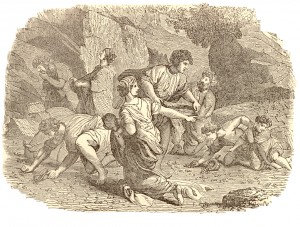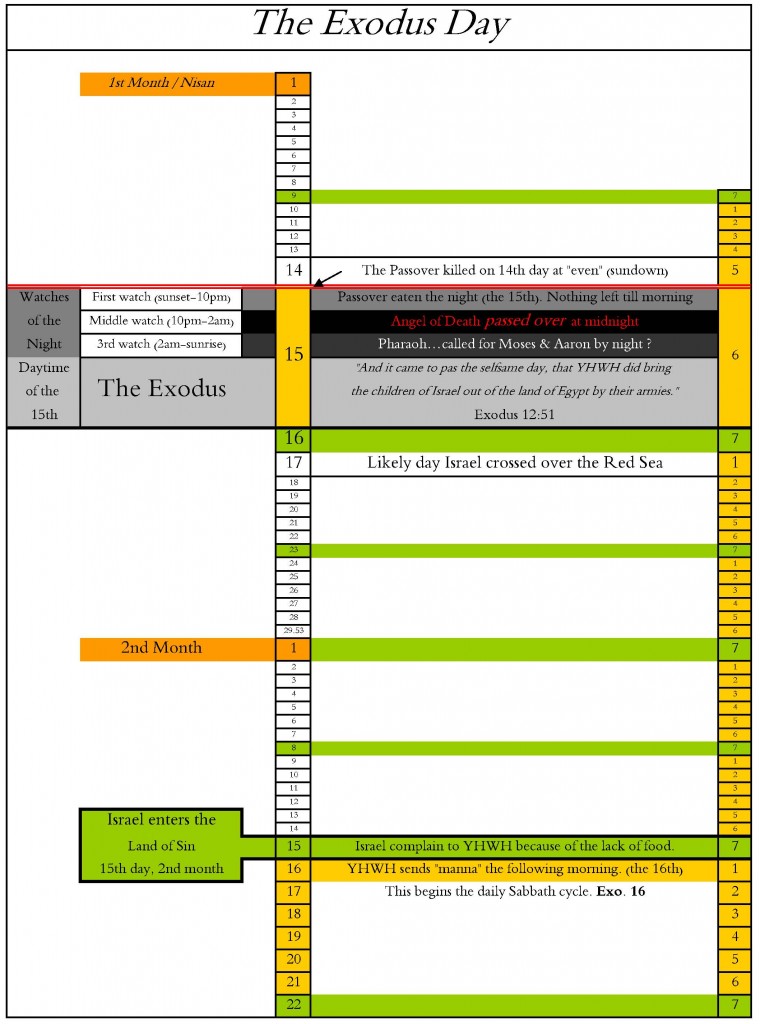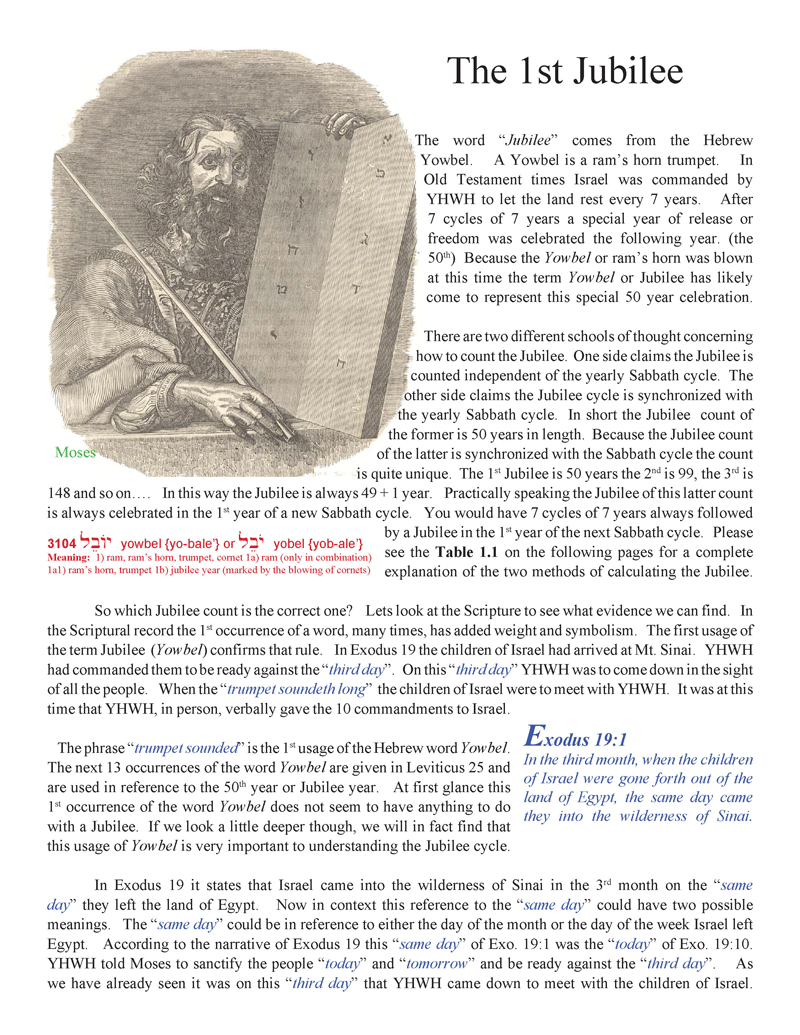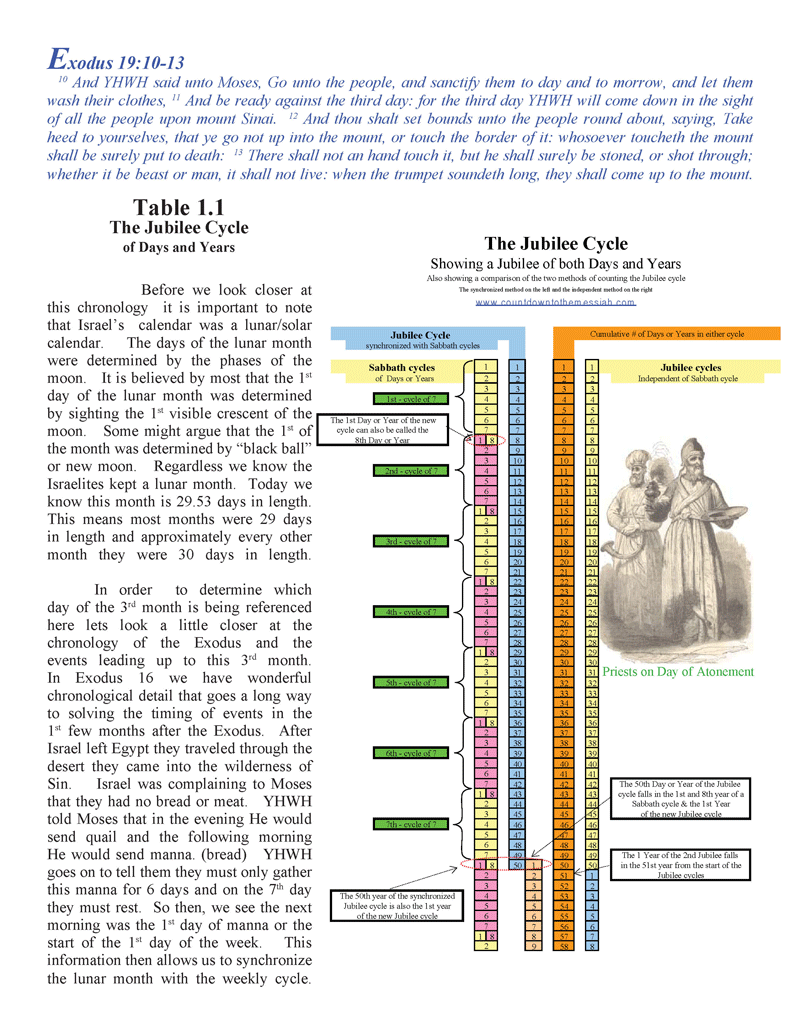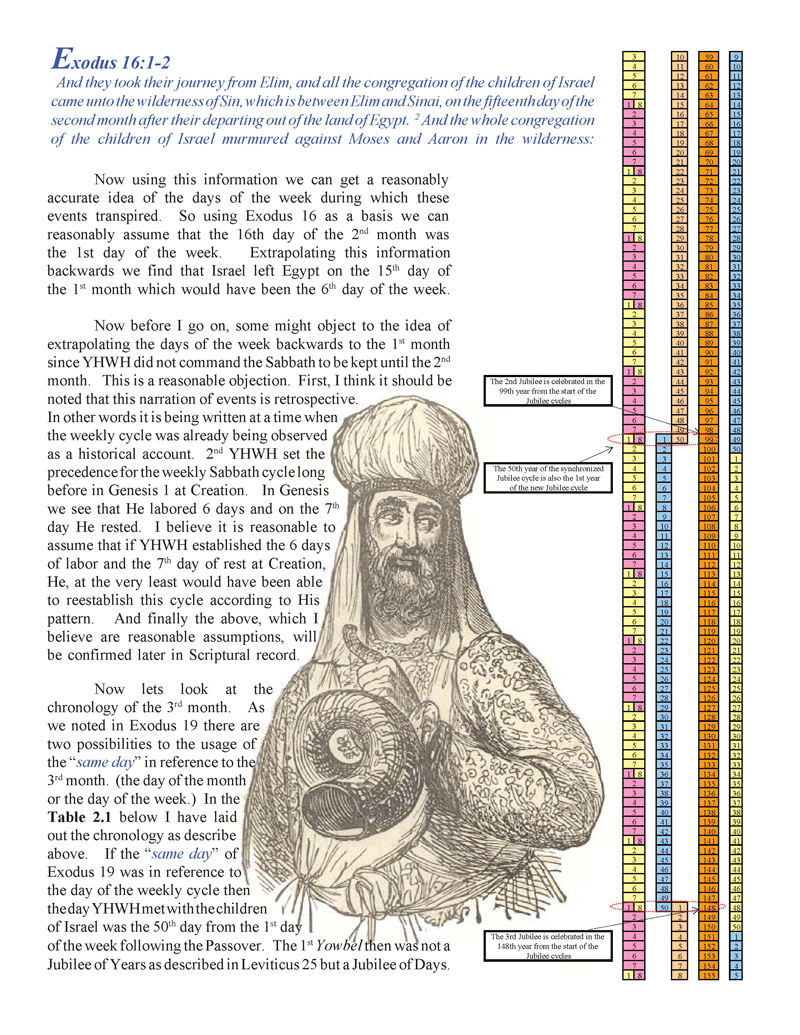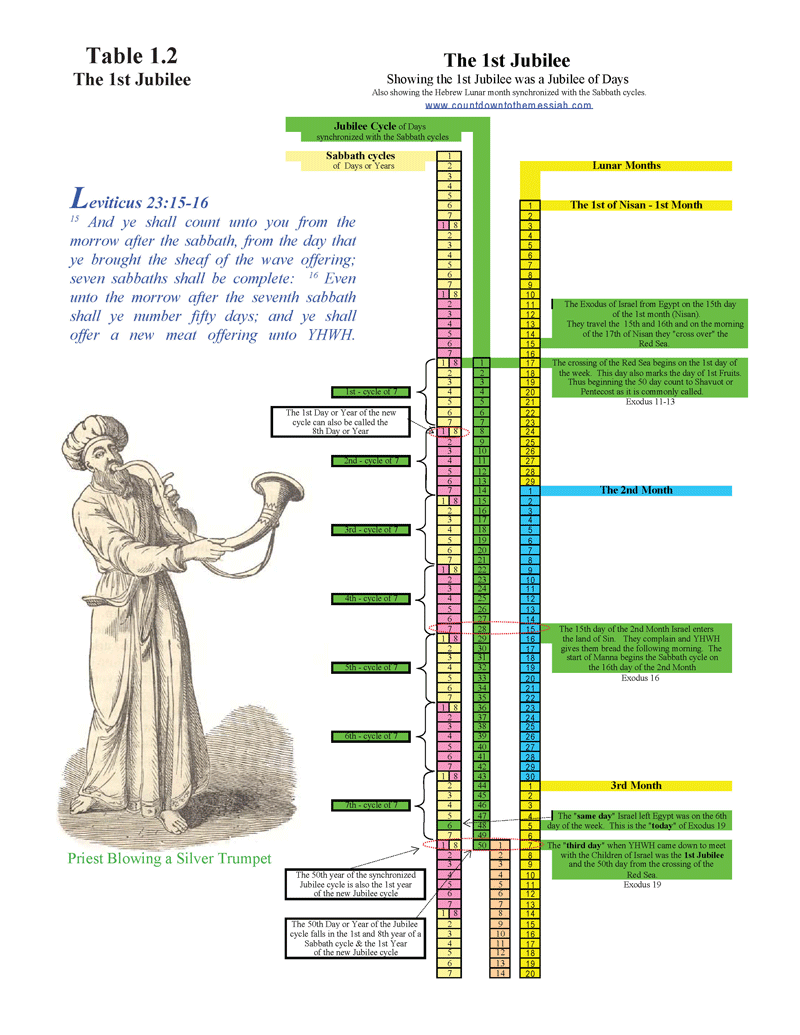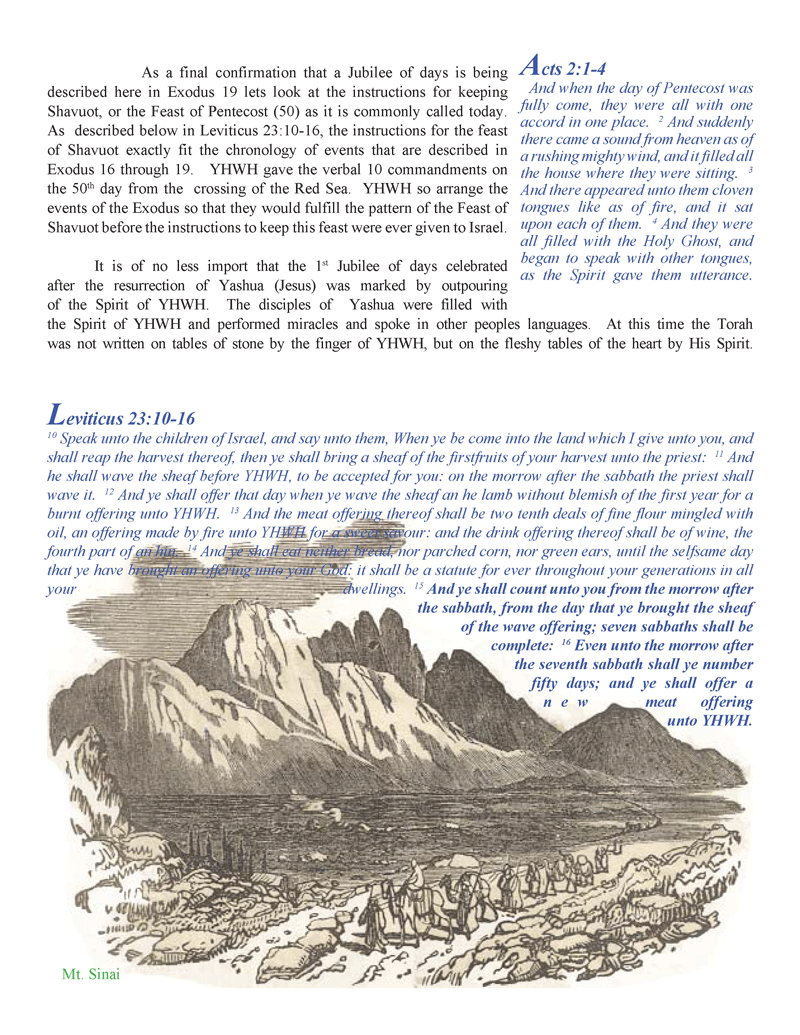 Part I – Exploring the Claim that Mount Sinai is in Saudi Arabia
Part I – Exploring the Claim that Mount Sinai is in Saudi Arabia
There are few stories in the Bible that capture our imagination more than the Exodus. It’s a story of the oppressed and the oppressor, of a tribe of shepherds who once favored, fall into disfavor when the winds of circumstance blow from another direction. It was those divine winds of circumstance that cast the once wealthy descendants of Abraham, Isaac, and Jacob into the crucible of slavery and oppression, and through which Yahweh, the living God of the Bible forged a nation of people with a special purpose in His redemptive plan for mankind.
Who doesn’t remember the Exodus stories of their youth? Of the faith and love of Moses’ mother, in order to save her precious son, cast him adrift in the reeds of the Nile rather than see him sacrificed by the calloused hands of the merciless Egyptians.
Who can’t remember at least some of those ten ghastly plagues Yahweh cast upon Pharaoh and the Egyptians because they wouldn’t let His people go. Which of us doesn’t shiver just a little when we picture the blood painted on the doors of Israel’s houses and the grim angel of death as it carried out the bloody sentence upon all of the firstborn in the land of Egypt who were not protected by the sacrificial blood of the lamb, on that fateful night?
And finally, in some way, I think, we can all related to the climax of the story as we stand with Israel on the shores of the Red Sea, our backs to the approaching enemy and we look in vain for a way out of our terrifying circumstances. Then with no hope in sight, Yahweh opens a way to deliverance. That’s the story of the Exodus!
Skeptical that Mount Sinai is in Arabia
With those wonderful and terrible pictures in mind, this week I want to explore the Exodus and the Red Sea crossing, with a goal in mind of providing as strong a historical and Biblical context to these events as I can. Although I’ve long had an interest in this subject, this article was inspired in part by Joel Richardson’s new book – Mount Sinai In Arabia: The True Location Revealed.
It is only fair to Mr. Richardson here to give you a bit of background to this article. A few months ago Mr. Richardson tweeted something about the location of Mt. Sinai that sparked my interest. I replied and we had a bit of back and forth on the subject. Mind you, I think it would be really cool if Mt. Sinai was in Saudi Arabia, but I’m not convinced this is the best understanding of the evidence. In fact, I am very skeptical of these claims. Our back and forth reflected this. But our conversation didn’t end in animosity, because Mr. Richardson did something that is rather rare today. Instead of blowing my criticisms off, he emailed me and asked if I’d give him some constructive criticism on parts of his forthcoming book related to our discussion.
To be up front, for reason we’ll explore in this series of articles, I still don’t agree with Mr. Richardson on the location of Mt. Sinai, but I definitely have a great deal more respect for him. Hats off to a brother in Christ who showed a bit of humility in his willingness seek out another point of view.
If you are interested in this subject I’d encourage you to read Mr. Richardson’s book. He makes a forceful case for Mt. Sinai’s location in Saudi Arabia. You’ll find an array of arguments (some stronger than others) that need to be explored and considered. No matter which side of this subject you take it’s a fascinating subject worthy of any Berean’s time and effort to better understand.
Vectors of Exploration
So, is Mt. Sinai really in Saudi Arabia? In this series of articles we’ll look at some of Mr. Richardson’s arguments in the light of the historical and Biblical context to see if these things be so.
In his book Mr. Richardson approaches the subject of the location of Mt. Sinai from two main angles of exploration. Those vectors include the location of the Red Sea crossing and geographical context of Arabia in light of the Biblical and historical evidence. Mr. Richardson uses these lines of exploration (to good effect I might add) to make his case for the “true” location of Mr. Sinai. His related conclusions are summed up in the following:
As we will see, the first clear reason to believe that Mount Sinai may now be found in modern day Saudi Arabia is because the Bible very specifically locates the Exodus sea crossing at the Gulf of Aqaba, also commonly known as the Red Sea….
Beyond being east of the Gulf of Aqaba, the Bible gives us a second critical witness regarding the location of Mount Sinai. As we will see, Scripture describes Mount Sinai as being either within the territory of, or beside the land of Midian. Thus, determining where Midian was located is essential. (Richardson, Joel. Mount Sinai in Arabia: The True Location Revealed (Kindle Locations 240-242 &535-537). WinePress Media. Kindle Edition.)
Because of the importance these lines of exploration play in Mr. Richardson’s thesis, I think some geographical and historical context related to the “Red” Sea, Egypt, and Arabia will be essential as we explore Mr. Richardson’s arguments. As part of this evidence we will closely examine how the New Testament authors understood the subject as well as their Greco-Roman contemporaries.
Why the Red Sea?
Did you know that the some of the first historical references to the term “Red” Sea come from the Greek’s and Romans? Now this is not the “Red” Sea you are probably picturing in your mind. You see, to the Greek’s and later to the Roman’s all of the bodies of water surrounding the Arabian Peninsula were part of the Erythraean Sea. Erythraean was the Greekword for Red. As reflected in the map below, they called the gulf on the western side of the Arabian Peninsula the “Arabian Gulf” and the gulf on the eastern side of the Arabian Peninsula the “Persian Gulf”. It’s important to keep in mind here that both gulfs were part of the Erythraean (Red) Sea proper.
No one really knows why the Greeks called these bodies of water the Erythraean (Red) Sea, but historians through the centuries theorized several reasons.
- They called it the Red Sea, because of the seasonal bloom of red algae sometimes observed.
- They called it the Red Sea, because of the red corral found in some of its waters. Æschylus, in the Prometheus Loosed as quoted by Strabo seems to confirm this view in the following quote: “There [is] the sacred wave, and the coralled bed of the Erythræan Sea,…. “ (The Geography of Strabo (Volume I, II & III of 3): Literally Translated, with Notes (Kindle Locations 795-798). Transcript. Kindle Edition.
- They called it the Red Sea, because Arabia was associated with the Edomites. Edom comes from the Hebrew word for “Red”.
For chronological context’s sake, keep in mind that the Greek or Hellenistic period began in the 4th century (roughly 323 BC) about the time of their conquest of Ptolemaic Egypt. Although their empire faded in 31 BC and the Battle of Actium, Greek thought was absorbed by the Roman Empire and has had considerable influence to this day.
The following map is based upon a Greek journal titled: Periplous of the Erythraean Sea (1st century AD). It reflects the Greek view of the Arabian Peninsula and the Erythraean Sea at the time.
The Greek Influence on the Septuagint
From a Biblical point of view, nowhere was this influence felt more than with the Septuagint version of the Bible. The Septuagint originated roughly 100 years into the Hellenistic period and in the very same location where historians attribute Greece’s rise to power, that is Ptolemaic Egypt. Traditionally, the Septuagint is thought to have originated in the reign of Ptolemy II Philadelphus of Egypt circa 285-246 BC. (For more on this see Paul Lawrence’s: A Brief History of the Septuagint on the ABR website.)
The reason this is important to our exploration of Mt. Sinai and the Red Sea crossing is that it is from the Septuagint that we get one of the earliest, if not the earliest, records of the bodies of water surrounding the Arabian Peninsula being called the Erythraean or Red Sea. Further, the New Testament confirms in two places that this “Erythraean Sea” was the location of Israel’s miraculous deliverance. As Mr. Richardson notes in his book, the Mesoretic text of the Old Testament on the other hand identifies these waters with the Yam Cuwph (Suf). Cuwph in Hebrew means reed or end. (We’ll explore idiosyncrasies of this Hebrew word in more detail later.)
In any case, we can pretty safely attribute the Hellenistic influence of the Septuagint for the Old Testament’s identification of the Red Sea with the bodies of water where the events of Exodus took place. The question is how do we relate the Greek Red Sea with the ancient Hebrew’s Yam Cuwph or Reed Sea?
Greco-Roman Confusion?
In order to answer these questions in the context of Mr. Richardson’s book, we need to look at his understanding of the Greco Roman world view of the Red Sea and Arabia, because this view informs the premises of his book. Here is how Mr. Richardson explains the subject:
The “Red Sea” was essentially a catch-all term used to refer to that distant sea that was very far south. It gets even more complicated though. The Greek geographers of this period actually did not have clarity regarding the piece of land known today as the Sinai Peninsula. The classical Greco-Roman geographers seem to have combined the Gulf of Suez and the Gulf of Aqaba into a single inlet that they called the Gulf of Arabia. In the Greek conception of the world then, there was simply Egypt in the west and the Arabian Peninsula to the east. The piece of land today called the Sinai Peninsula was so obscure that it was almost as if it didn’t even exist. (Richardson, Joel. Mount Sinai in Arabia: The True Location Revealed (Kindle Locations 264-268). WinePress Media. Kindle Edition.)
In the fifth century BC, the Greek historian Herodotus used the term “Arabia” to identify the Arabian Peninsula. In fairness, however, as we have discussed elsewhere, even though Herodotus was not aware that the Sinai Peninsula even existed, he still would have viewed it to be part of Arabia. In the writings of Strabo, another Greek historian-geographer who lived in the first century BC, the Arabian Peninsula continued to be the heartland of Arabia and was called Arabia Felix (meaning “happy,” “blessed,” “fortunate Arabia”). Another smaller region in southern Jordan was called Arabia Deserta. So while it is most certainly possible that in Paul’s day references to Arabia could have been pointing to the Sinai Peninsula, this would have been much more of a secondary reference. If no qualifier was given, the Arabian Peninsula would likely have been understood as the primary region. (Richardson, Joel. Mount Sinai in Arabia: The True Location Revealed (Kindle Locations 1041-1048). WinePress Media. Kindle Edition.)
In the above statements Mr. Richardson seems to be under the impression that the Greco-Roman world had a rather vague or limited understanding of geographical location related to their Red Sea and the Sinai Peninsula. A careful reading of the Greek and Roman historians does not seem to bear this out. The following are a couple of examples:
The Histories by Herodotus (484 -425 BC)
In Arabia, not far from Egypt, there is a long and narrow gulf running inland from the sea called the Erythraean, of which I will here set down the dimensions. Starting from its innermost recess, and using a row-boat, you take forty days to reach the open main, while you may cross the gulf at its widest part in the space of half a day. In this sea there is an ebb and flow of the tide every day. My opinion is that Egypt was formerly very much such a gulf as this— one gulf penetrated from the sea that washes Egypt on the north, and extended itself towards Ethiopia; another entered from the southern ocean, and stretched towards Syria; the two gulfs ran into the land so as almost to meet each other, and left between them only a very narrow tract of country. (Herodotus. The Histories by Herodotus (Enhanced Kindle Edition) (Kindle Locations 1773-1782). Kindle Edition.)
Pliny the Elder, a Roman contemporary of Yeshua and the Apostle Paul had this to say about geographical location of the Red Sea and the geography of the Gulf of Arabia.
CHAP. 12. — THE COASTS OF ARABIA, SITUATE ON THE EGYPTIAN SEA. Beyond the Pelusiac Mouth is Arabia3597[petraea], which extends to the Red Sea, and joins the Arabia known by the surname of Happy3598 [Arabia Felix], so famous for its perfumes and its wealth. This3599 is called Arabia of the Catabanes3600, the Esbonitæ3601, and the Scenitæ3602; it is remarkable for its sterility, except in the parts where it joins up to Syria, and it has nothing remarkable in it except Mount Casius3603. The Arabian nations of the Canchlæi3604 join these on the east, and, on the south the Cedrei3605, both of which peoples are adjoining to the Nabatæi3606.
The two gulfs of the Red Sea, where it borders upon Egypt, are called the Heroöpolitic3607[gulf of Suez] and the Ælanitic3608[gulf of Aqaba]. Between the two towns of Ælana3609 and Gaza3610 upon our sea3611[Mediteranian], there is a distance of 150 miles. Agrippa says that Arsinoë3612, a town on the Red Sea, is, by way of the desert, 125 miles from Pelusium. How different the characteristics impressed by nature upon two places separated by so small a distance! (Pliny the Elder [23-79 AD]. The Natural History of Pliny, Volume 1 (of 6) / by Pliny, the Elder (Kindle Locations 6928-6948). )((Inserts in brakets [] were added by WS for clarity))
Here is a visual of how the Arabian provinces were divided in the Roman times. 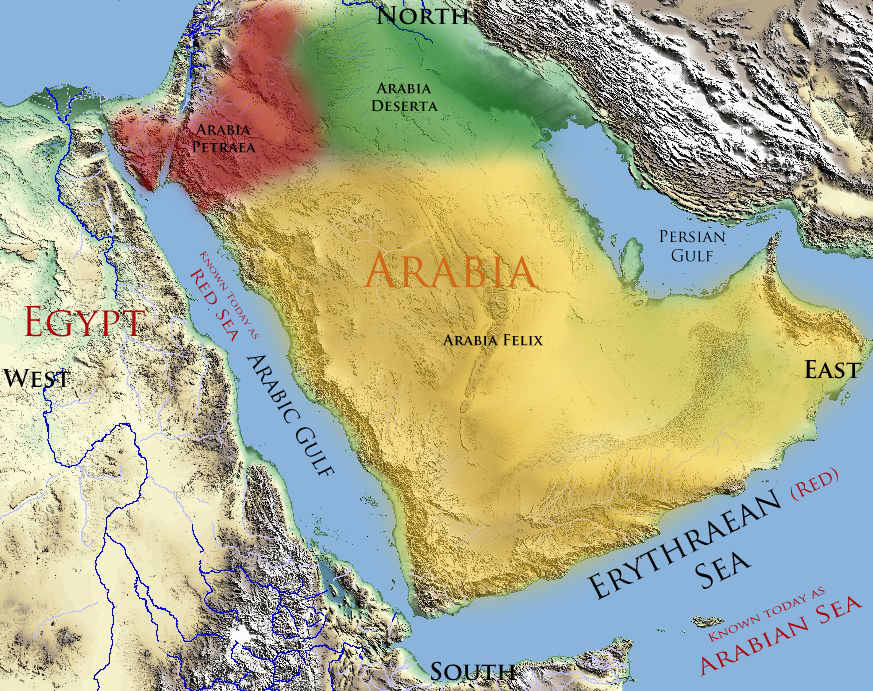
From the above quotes you get the sense that the Greco-Roman geographers did in fact have a rather clear understanding of the Egyptian and Arabian geography.
A couple things to note from these 1st century geographers: First, they understood the Erythraean Sea (Red Sea) to have two gulfs. Pliny described them as the Heroopolitic and the Aelanitic. Further, he understood that the Heroopolitic gulf (today known as the Suez) to be the border between Egypt and Arabia.
What is fascinating about this information is that other Greco-Roman historians as well as archeologists of the modern age identify Heroopolitic gulf and its city Heroopolis with the ancient treasure city of Phitom mentioned in Exodus.
There are a couple neat facts about this information. First, Heroopolis was an important harbor on the Arabic gulf (gulf of Suez) in the Red Sea. This harbor was located all the way up in the area of what today is known as Lake Timsah in the Bitter Lakes of Egypt. This shows that the Red Sea in the days of the Greeks and Romans (and before) terminated much further north than its present location at Suez. (Keep this in mind for later because it becomes quite important information as we look at the route Israel took when they left Egypt.)
Strabo Defines Arabia and the Red Sea
The Greek geographer Strabo who lived from 63 BC – AD 23 confirms the status of Heroopolis as located on “recess” of the Arabian Gulf (gulf of Suez).
…They [who accuse Homer of ignorance] are again mistaken when they say that he was not aware of the isthmus between the sea of Egypt and the Arabian Gulf, and that his description is false,… (Strabo. The Geography of Strabo (Volume I, II & III of 3): Literally Translated, with Notes (Kindle Locations 725-726). Transcript. Kindle Edition.) ((Inserts in brakets [] added by WS for clarity))
In addition to the length, the recess of the Gulf [Arabic Gulf ] is distant from the sea at Pelusium only three or four days’ journey across the isthmus. [Pelusium is a famous city on the Nile Delta near the Mediterranean Sea.] (Strabo. The Geography of Strabo (Volume I, II & III of 3): Literally Translated, with Notes (Kindle Locations 849-850). Transcript. Kindle Edition.)
Egypt too [he says] was formerly covered by sea as far as the marshes near Pelusium, 321 Mount Casius, 322 and the Lake Sirbonis. 323 Even at the present time, when salt is being dug in Egypt, the beds are found under layers of sand and mingled with fossil shells, as if this district had formerly been under water, and as if the whole region about Casium and Gerrha324 had been shallows reaching to the Arabian Gulf. The sea afterwards receding left the land uncovered, and the Lake Sirbonis remained, which having afterwards forced itself a passage, became a marsh. (Strabo. The Geography of Strabo (Volume I, II & III of 3): Literally Translated, with Notes (Kindle Locations 1227-1232). Transcript. Kindle Edition.)
Now the latitude of Heroopolis is about the same as Alexandria, or rather more south. (Strabo. The Geography of Strabo (Volume I, II & III of 3): Literally Translated, with Notes (Kindle Locations 2038-2039). Transcript. Kindle Edition.)
There is said to be a passage thence across, of 1260 stadia, to the city Aila623 (Aelana), situated on the innermost recess of the Arabian Gulf. This recess has two branches, one, in the direction of Arabia and Gaza, is called Ailanites, from the city upon it; the other is in the direction of Egypt, towards Heroopolis, 624 to which from Pelusium is the shortest road (between the two seas). (Strabo. The Geography of Strabo (Volume I, II & III of 3): Literally Translated, with Notes (Kindle Locations 27453-27457). Transcript. Kindle Edition.)
I return to the opinions of Eratosthenes [Greek scholar 276-195BC], which he next delivers respecting Arabia. He is speaking of the northern and desert part, lying between Arabia Felix, Cœle-Syria, and Judæa, to the recess of the Arabian Gulf. From Heroopolis, situated in that recess of the Arabian Gulf which is on the side of the Nile,…(Strabo. The Geography of Strabo (Volume I, II & III of 3): Literally Translated, with Notes (Kindle Locations 27665-27668). Transcript. Kindle Edition.)
Here is a map reflecting Strabo’s view of Egypt and Arabia’s geography. 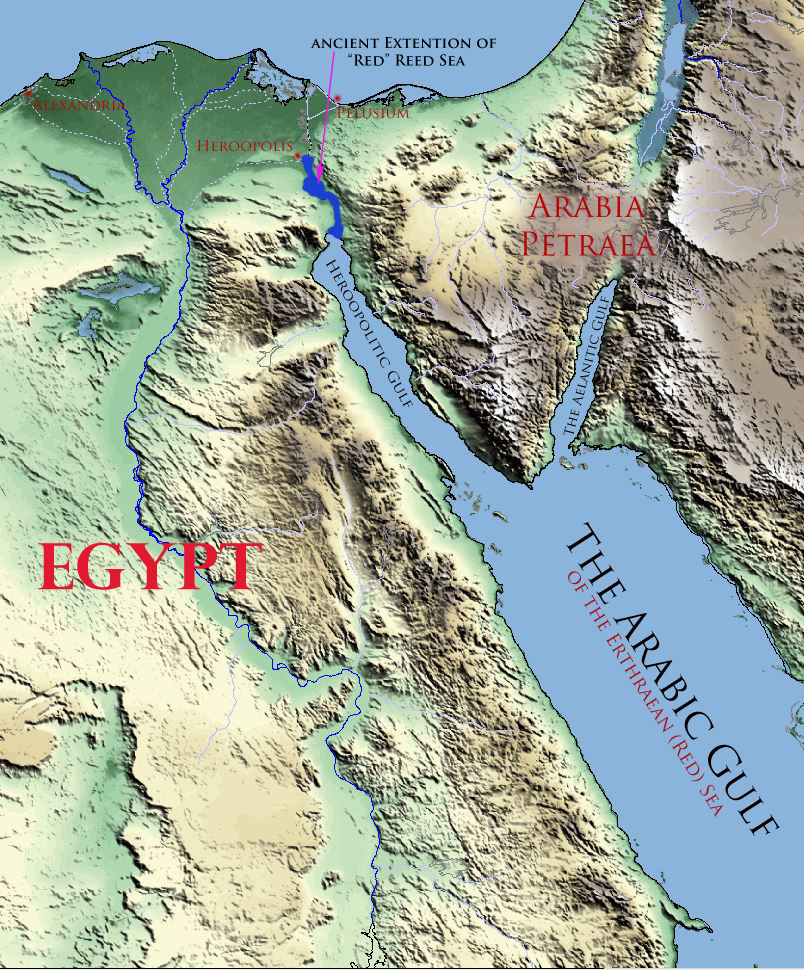 [DISPLAY_ULTIMATE_PLUS]
[DISPLAY_ULTIMATE_PLUS]
Frontier Fortifications
Before we really dig into the specific details of Mr. Richardson’s arguments regarding the location of the “Red Sea” and Mt. Sinai, there is one more piece of historical information that we need to explore so that you will better understand the context of Israel’s captivity in Egypt and their Exodus. I believe this context will dramatically change how you view Israel’s captivity and the route they took when leaving the land of Goshen.
And afterward Moses and Aaron went in, and told Pharaoh, Thus saith YHWH God of Israel, Let my people go, that they may hold a feast unto me in the wilderness. And Pharaoh said, Who is YHWH, that I should obey his voice to let Israel go? I know not YHWH, neither will I let Israel go. (Exodus 5:1-2)
Have you ever thought about how Pharaoh kept Israel from leaving Egypt? I mean, why couldn’t they just immigrate in mass or a few families at a time? From the verses above it kind of sounds like the Israelites were prisoners. How could Pharaoh have kept all Israel prisoner?
These circumstances make a lot more sense when you understand that it just wasn’t possible for Israel to leave Egypt without Pharaoh’s permission. In fact it is likely that the Israelites would have needed today’s equivalent of a passport. Let me explain.
As we learned from the history we’ve explored above, Eastern Egypt was protected with the natural barrier of the Red Sea all the way up to city of Heroopolis (the Biblical Phitom) near present day lake Timsah. Between Heroopolis and Pelusium (on the MediterranianSea) there were roughly 40 miles of land not guarded by the natural barrier of the Red Sea. According to archeologists, during the reign of Seti I, due to concerns of invasion from their Asiatic neighbors, a frontier wall (included moats) was constructed across this northeastern section of Egypt’s frontier border. This wall had guard towers and was garrisoned with soldiers. While this frontier fortification did indeed keep unwanted guests from entering Egypt from the east it also kept anyone from leaving Egypt without Pharaoh’s permission.
So when the Bible describes Moses asking permission for Israel to leave Egypt, this permission was in fact necessary because no individual could leave Egypt without passing through the gates of the frontier wall, much less hundreds of thousands Israelites who were valuable slaves.
With the same object he constructed on his north-eastern frontier a wall or fortress “to keep out the Sakti,” who continually harassed the people of the Eastern Delta by their incursions. (Rawlinson, George. The History of Ancient Egypt: The Land & The People of Egypt, Egyptian Mythology & Customs, The Pyramid Builders, The Rise of Thebes, The Reign of the … The Ethiopians & Persian Conquest (Kindle Locations 1010-1011). Madison & Adams Press. Kindle Edition.)
Seti was not dazzled with his military successes. Notwithstanding his triumphs in Syria, he recognized the fact that Egypt had much to fear from her Asiatic neighbours, and could not hope to maintain for long her aggressive attitude in that quarter. Without withdrawing from any of the conquered countries, while still claiming their obedience and enforcing the payment of their tributes, he began to made preparation for the changed circumstances which he anticipated by commencing the construction of a long wall on his north-eastern frontier, as a security against invasion from Asia. This wall began at Pelusium, and was carried across the isthmus in a south-westerly direction by Migdol to Pithom, or Heroopolis, where the long line of lagoons began, which were connected with the upper end of the Red Sea. (Rawlinson, George. The History of Ancient Egypt: The Land & The People of Egypt, Egyptian Mythology & Customs, The Pyramid Builders, The Rise of Thebes, The Reign of the … The Ethiopians & Persian Conquest (Kindle Locations 2275-2285). Madison & Adams Press. Kindle Edition.)
We may conclude that Seti was of the true Egyptian race, with perhaps an admixture of more southern blood; while Ramesses, born of a Semitic mother, inherited through her Asiatic characteristics, and, though possessing less energy and strength of character than his father, had a more sensitive temperament, a wider range of taste, and a greater inclination towards peace and tranquillity. His important wars were all concluded within the limit of his twenty-first year, while his entire reign was one of sixty-seven years, during fifty of which he held the sole sovereignty. Though he left the fame of a great warrior behind him, his chief and truest triumphs seem to have been those of peace—the Great Wall for the protection of Egypt towards the east, with its strong fortresses and “store-cities,” the canal which united the Nile with the Red Sea, and the countless buildings, excavations, obelisks, colossal statues, and other great works, with which he adorned Egypt from one end to the other. (Rawlinson, George. The History of Ancient Egypt: The Land & The People of Egypt, Egyptian Mythology & Customs, The Pyramid Builders, The Rise of Thebes, The Reign of the … The Ethiopians & Persian Conquest (Kindle Locations 2425-2432). Madison & Adams Press. Kindle Edition.)
There lay still further to the NORTHEAST, on the western border of the lake called Sirbonis, a place important for the defence of the frontier, called ANBU, that is “THE WALL,” “THE RAMPART WALL,” “THE CIRCUMVALLATION.” It is frequently mentioned by the ancients, though not under its Egyptian appellation, but in the form of a translation. The Hebrews call it SHUR, that is, “WALL,” and the Greeks Gerrhon, Gerrha which means “THE FENCES” or “ENCLOSURES.”….
Whoever travelled EASTWARDS from Egypt, in order to leave the country, WAS OBLIGED to pass the place of “the walls,” before he was ALLOWED to enter the “road of the Philistines,” as it is called in Holy Writ, on his further journey. An Egyptian garrison, under the command of a captain, BLOCKED THE PASSAGE THROUGH THE FORTRESS, which only opened and closed on the suspected traveller AFTER A PREVIOUS COMMUNICATION FROM THE ROYAL AUTHORITIES. Anbu — Shur — Gerrhon formed at the same time the first terminal point of the great military road, which led from the Delta…to the…desert ….(A History of Egypt Under the Pharaohs, by Henry Brugsch-Bey. Vol.I, second edition. John Murray, London. 1881, pps. 238-239.)
“Accounts of this wall indicate a project on the scale of the frontier wall of Britain, built by the Roman emperor Hadrian” — and known to history as “Hadrian’s Wall.” (The Egyptian Pyramids, McFarland and Co., Jefferson, N.C. 1990, p. 198.)
From recent discoveries we know that though Amenemhet I, the Enemy of the Petrograd papyrus, was regarded as the saviour of Egypt, and was the builder of the great wall in the Eastern Delta made to keep back the Asiatics, yet the war of liberation had already begun under his predecessors of the Xlth Dynasty, the Antefs and Mentuhotps of Thebes, and the retirement of Abram may conceivably have been due to pressure by the Egyptian armies. (Peet, T.E. Egypt and the Old Testament (Kindle Locations 508-513). Liverpool, University Press of Liverpool ltd.. Kindle Edition.)
The Chronological Context of Egypt and the Exodus
To help you understand the context of the quotes above related to Amenemhet I and Seti I, the great wall and the Exodus, the following chart shows the Egyptian Dynasties XVIII and XIX. According to the MT text of the Old Testament, the Exodus took place about 1488 BC. (These charts were adapted by this author based upon the charts of D. Davidson and C. Aldersmith. – WS) [DISPLAY_ULTIMATE_PLUS]
In Summary
From the historical references we’ve explored in this article, it is clear that the Greco-Roman world of the apostle Paul’s day understood that the Erythraean Sea or Red Sea was a body of water which surrounded Arabia. Further they understood that this Red Sea included the Heroopolitic gulf (Suez) and Aelantic gulf (Aqaba) and further that this Heroopolactic gulf (Suez) was the border between Egypt and Arabia.
So in the New Testament when Stephen and the author of Hebrews mentions the “Erythraean” or Red Sea as the location of the Exodus sea crossing, that term in context of their day included both the Heroopolitic (Suez) and Aelantic (Aqaba) gulfs of the Erythraean Sea. The bottom line is that what we know today as the Sinai, both the New Testament and the Greco-Roman historians understood to be part of Arabia. The question remains though, – in which part of Arabia was Mt. Sinai located? We’ll explore this question in more detail in Part II of this series.
A Fun Challenge: How did Israel Leave Egypt?
We’ll continue our exploration of the Exodus, the Red Sea crossing, and the location of Mt. Sinai in Part II of this series, but as you think about the information I’ve shared in this article I challenge you with an exercise in logistics.
There are two main theories today regarding the Gulf of Aqaba as the location of the Red Sea crossing. These theories are best represented by Ron Wyatt and Bob Cornuke. If you take a look at both their maps or drawings of the proposed Red Sea crossing you’ll notice they make no mention of the ancient position of the Heroopolitic gulf of the Erythraean (Red) Sea or the frontier wall in their Exodus route itineraries. (Mr. Richardson does not cover this subject in this book.)
In any case, here is a fun challenge for those of you who’ll accept it. Most scholars claim that roughly 2 million Israelites left Egypt plus a great deal of cattle and livestock. Assuming each person or animal took up only 4 sq. ft., and assuming they only took 500K livestock with them when they left, how many miles long would the column of Israelites and livestock have been when they passed through the frontier gate of Egypt into the wilderness of Sinai (if said gate was 100’ wide). And as a secondary exercise, with the above information in mind, how long would it have taken this column of Israelites to leave Egypt proper (the Nile river valley) and enter the wilderness of Sinai based upon Ron Wyatt’s or Bob Cornuke’s itineraries of the Exodus. I’d love to hear your thoughts on this. We’ll consider the implications of this logistical challenge in our next article.
In Part II we we’ll look at several subjects related to Mr. Richardson’s book – including:
- The Hebrew usage of Yam Cuwph
- The Logistics of Israel’s exodus through the Northwestern frontier
- What was meant by “out of Egypt” as it relates to the Red Sea crossing.
- The Red Sea and the Locusts
Yahweh willing until next time – Maranatha!
A Favor to Ask
I have a favor to ask. If you are a regular reader of this blog, you know that you can download all of my books and articles free of charge. I don’t ask for donations or allow advertisements on this blog. This effort is a labor of love for me as a testimony to Yahweh’s wonderful redemptive plan for mankind through Yeshua. I don’t want your money but if you would take a moment to share the articles you read on this blog with your friends and family on Facebook, Twitter, and other social media I would greatly appreciate your help. Together we can share the Biblical evidence for Yahweh’s wonderful redemptive plan for mankind. Thank you for your help in this effort!
* * *
FREE Book Download:
If you would like to learn more about Biblical history and Bible prophecy, you might also appreciate my books in the Prophecies and Patterns series.
At the following link you may download one of the three books shown below. If you like the book and would like to download the other two, all I ask is that you subscribe to my blog. I won’t share your email or spam you with advertisements or other requests. Just every couple of weeks I’ll share with you my love of Biblical history and Bible Prophecy. Should you decide you no longer wish to be a subscriber you can unsubscribe at any time.
Click the following link to download your Free book: Book Download
I hope you’ll join the adventure!
Editors Note: Below are some additional quotes I dug out that might be of interest to some of you. They give a more nuanced view of the how Egypt and Arabian were viewed in the Greco-Roman period as well as some related miscellaneous information.
At last nothing remained to the invaders but their great fortified camp, Uar or Auaris, which they had established at the time of their arrival upon the eastern frontier, and had ever since kept up. In this district, which was strongly fortified by walls and moats, and watered by canals derived from the Pelusiac branch of the Nile, they had concentrated themselves, we are told, to the number of 240,000 men, determined to make there a final stand against the Egyptians. (Rawlinson, George. The History of Ancient Egypt: The Land & The People of Egypt, Egyptian Mythology & Customs, The Pyramid Builders, The Rise of Thebes, The Reign of the … The Ethiopians & Persian Conquest (Kindle Locations 1496-1499). Madison & Adams Press. Kindle Edition.)
Amenemhat [I] ruled over the WHOLE LAND OF EGYPT with power and might, “from the Elephant-city even to the Athu, or lakes in the lowlands;” and that he was wise in thought and deed we learn from many a phrase in the long since faded papyri of ancient origin. Let us first consider the childlike simple narrative OF HIS CONTEMPORARY, the Egyptian SINEH [SINUHE], who, from some unknown cause, left the court of his lord and king, and TOOK THE ROAD TOWARDS THE NORTHEAST TO ESCAPE OUT OF THE LAND OF HIS FATHERS. Manifold dangers threatened him in his flight, from the keepers of the roads, and from foreign tribes, who, leading an unsettled nomad life on the eastern frontiers of the kingdom, caused the wanderer much care and disquietude. THERE IN THE EAST THE OBSTRUCTION OF THE GREAT “WALL” BARRED THE OPEN ROAD. What the Egyptians called ANBU, i.e. “wall,” was called in other languages better known to us, SHUR (Hebrew, “wall”) or Gerrhon (Greek, “enclosure,” “bounds”), both designating the fortress at the entrance of the narrow causeway between the Egyptian (Mediterranean) Sea and the Lake Sirbonis, through which the OLD HIGH ROAD LED FROM THE LAND OF KEMI [EGYPT] TO THE CITIES OF THE RUTEN. Sineh escapes the vigilance of the watchmen on the “Wall,” and enters the barren, desolate wilderness. — (A History of Egypt Under the Pharaohs, pps.146-147.)
…we must admit that formerly, under the dominion of the Romans, the Red Sea extended MUCH FARTHER NORTH than it does now; but that then the RETREAT OF THE SEA, and the changes in the surface of the soil had already begun to be felt.
Not only were the BITTER LAKES UNDER WATER, but I believe we are compelled to admit with Linant Bey, who derives his arguments from GEOLOGY, that Lake Timsah, and the valleys of Saba Biar and Abu Balah were, under the Pharaohs, PART OF THE SEA. Some traces of this may be seen on the map of the French engineers drawn at the end of last century [18th]. Contiguous to Lake Timsah there is a narrow extension towards the west which has the appearance of the HEAD OF A GULF. Thus the sea would have extended as far as the place now called Magfar….
It must have been at the head of the gulf…that the upheaval of the soil, and the RETREAT OF THE SEA were first felt. Gradually, the water sank, the communication with the gulf was partly cut off, and there remained SALT MARSHES such as are seen at present in several parts of the Delta, and which were called by Strabo and Pliny THE BITTER LAKES. — (The Store-City of Pithom and the Route of the Exodus, by Edouard Naville. Second edition. Messrs. Trubner and Co., London. 1885, p. 21.)
An interesting commentary on the legend has been furnished by a papyrus lately acquired by M. Golénischeff, and dating from the age of Thothmes iii. On the last page is a sort of Messianic prophecy, the hero of which has the name of Ameni, a shortened form of Amenôphis. “A king,” it says, “will come from the south, Ameni the truth-declaring by name. He will be the son of a woman of Nubia, and will be born in…. He will assume the crown of Upper Egypt, and will lift up the red crown of Lower Egypt. He will unite the double crown…. The people of the age of the son of man ( sic ) will rejoice and establish his name for all eternity. They will be far from evil, and the wicked will humble their mouths for fear of him. The Asiatics (Âmu) will fall before his blows, and the Libyans before his flame. The wicked will wait on his judgments, the rebels on his [pg 095] power. The royal serpent on his brow will pacify the revolted. A wall shall be built, even that of the prince, so that the Asiatics may no more enter into Egypt.” (Sayce, A. H. (Archibald Henry). The Egypt of the Hebrews and Herodotos (pp. 74-75). Kindle Edition.)
It can hardly be doubted that the epithet Erythraean (which means red,…) first designated the Arabian Gulf or Red Sea, and was afterwards extended to the seas beyond the Straits by those who first explored them. The Red Sea was so called because it washed the shores of Arabia, called the Red Land (Edom), in contradistinction to Egypt, called the Black Land (Kemi), from the darkness of the soil deposited by the Nile. (McCrindle, John. The commerce and navigation of the Erythraean sea (Kindle Locations 2873-2880). Calcutta, Thacker, Spink & co.; [etc., etc.]. Kindle Edition.)
Psammetichus left a son called Necos, who succeeded him upon the throne. This prince was the first to attempt the construction of the canal to the Red Sea—a work completed afterwards by Darius the Persian—the length of which is four days’ journey, and the width such as to admit of two triremes being rowed along it abreast. The water is derived from the Nile, which the canal leaves a little above the city of Bubastis, near Patumus, the Arabian town, being continued thence until it joins the Red Sea. At first it is carried along the Arabian side of the Egyptian plain, as far as the chain of hills opposite Memphis, whereby the plain is bounded, and in which lie the great stone quarries; here it skirts the base of the hills running in a direction from west to east, after which it turns and enters a narrow pass, trending southwards from this point until it enters the Arabian Gulf. From the northern sea to that which is called the southern or Erythraean, the shortest and quickest passage, which is from Mount Casius, the boundary between Egypt and Syria, to the Gulf of Arabia, is a distance of exactly one thousand furlongs. But the way by the canal is very much longer on account of the crookedness of its course. A hundred and twenty thousand of the Egyptians, employed upon the work in the reign of Necos, lost their lives in making the excavation. He at length desisted from his undertaking, in consequence of an oracle which warned him “that he was labouring for the barbarian.” The Egyptians call by the name of barbarians all such as speak a language different from their own. Herodotus. The Histories by Herodotus (Enhanced Kindle Edition) (Kindle Locations 2917-2928). Kindle Edition.
Thus I give credit to those from whom I received this account of Egypt, and am myself, moreover, strongly of the same opinion, since I remarked that the country projects into the sea further than the neighbouring shores, and I observed that there were shells upon the hills, and that salt exuded from the soil to such an extent as even to injure the pyramids; and I noticed also that there is but a single hill in all Egypt where sand is found, namely, the hill above Memphis; and further, I found the country to bear no resemblance either to its borderland Arabia, or to Libya—nay, nor even to Syria, which forms the seaboard of Arabia; but whereas the soil of Libya is, we know, sandy and of a reddish hue, and that of Arabia and Syria inclines to stone and clay, Egypt has a soil that is black and crumbly, as being alluvial and formed of the deposits brought down by the river from Ethiopia. (Herodotus. The Histories by Herodotus (Enhanced Kindle Edition) (Kindle Locations 1782-1788). Kindle Edition.)
Now the Nile, when it overflows, floods not only the Delta, but also the tracts of country on both sides the stream which are thought to belong to Libya and Arabia, in some places reaching to the extent of two days’ journey from its banks, in some even exceeding that distance, but in others falling short of it. (Herodotus. The Histories by Herodotus (Enhanced Kindle Edition) (Kindle Locations 1839-1842). Kindle Edition.)
The other starts from the country of the Persians, and stretches into the Erythraean sea, containing first Persia, then Assyria, and after Assyria, Arabia. It ends, that is to say, it is considered to end, though it does not really come to a termination, at the Arabian gulf—the gulf whereinto Darius conducted the canal which he made from the Nile. (Herodotus. The Histories by Herodotus (Enhanced Kindle Edition) (Kindle Locations 4555-4557). Kindle Edition)
Arabia Petraea or Petrea, also known as Rome’s Arabian Province (Latin: Provincia Arabia; Arabic: العربية البترائية) or simply Arabia, was a frontier province of the Roman Empire beginning in the 2nd century; it consisted of the former Nabataean Kingdom in Jordan, southern Levant, the Sinai Peninsula and northwestern Arabian Peninsula. Its capital was Petra. It was bordered on the north by Syria, on the west by Iudaea (merged with Syria from AD 135) and Aegyptus, and on the south and east by the rest of Arabia, known as Arabia Deserta and Arabia Felix. (https://en.wikipedia.org/wiki/Arabia_Petraea)
From Heroopolis, situated in that recess of the Arabian Gulf which is on the side of the Nile, to Babylon, towards Petra of the Nabatæi, are 5600 stadia. The whole tract lies in the direction of the summer solstice (i. e. east and west), and passes through the adjacent Arabian tribes, namely Nabatæi, Chaulotæi, and Agræi. Above these people is Arabia Felix, stretching out 12,000 stadia towards the south to the Atlantic Sea. (Strabo. The Geography of Strabo (Volume I, II & III of 3): Literally Translated, with Notes (Kindle Locations 27667-27670). Transcript. Kindle Edition.)
On this quarter Egypt is difficult of access, i. e. from the eastern side towards Phœnicia and Judæa, and on the side of Arabia Nabatæa, which is contiguous; through which countries the road to Egypt lies. The country between the Nile and the Arabian Gulf is Arabia, and at its extremity is situated Pelusium. But the whole is desert, and not passable by an army. The isthmus between Pelusium and the recess of the Arabian Gulf near Heroopolis is 1000 stadia; but, according to Poseidonius, less than 1500 stadia in extent. Besides its being sandy and without water, it abounds with reptiles, which burrow in the sand. (Strabo. The Geography of Strabo (Volume I, II & III of 3): Literally Translated, with Notes (Kindle Locations 28496-28500). Transcript. Kindle Edition.)
On setting out from Pelusium, the first canal met with is that which fills the lakes, “near the marshes,” as they are called. There are two of these lakes, situated upon the left hand of the great stream above Pelusium in Arabia. He mentions other lakes also, and canals in the same parts beyond the Delta. The Sethroïte Nome extends along one of the two lakes. He reckons this as one of the ten nomes in the Delta. There are two other canals, which discharge themselves into the same lakes. 25. There is another canal also, which empties itself into the Red Sea, or Arabian Gulf, near the city Arsinoë, which some call Cleopatris. 843 It flows through the Bitter Lakes, as [Pg 244] [CAS. 804] they are called, which were bitter formerly, but when the above-mentioned canal was cut, the bitter quality was altered by their junction with the river, and at present they contain excellent fish, and abound with aquatic birds. (Strabo. The Geography of Strabo (Volume I, II & III of 3): Literally Translated, with Notes (Kindle Locations 28522-28531). Transcript. Kindle Edition.)
After Heliopolis is the “Nile above the Delta.” The country on the right hand, as you go up the Nile, is called Libya, as well as that near Alexandreia and the lake Mareotis; the country on the left hand is called Arabia. The territory belonging to Heliopolis is in Arabia, but the city Cercesura is in Libya, and situated opposite to the observatory of Eudoxus. For there is shown an observing station in front of Heliopolis, as there is in front of Cnidus, where Eudoxus marked certain motions of the heavenly bodies. This is the Letopolite Nome. (Strabo. The Geography of Strabo (Volume I, II & III of 3): Literally Translated, with Notes (Kindle Locations 28579-28583). Transcript. Kindle Edition.)
I have said elsewhere, 861 that in sight of the pyramids, on the other side in Arabia, and near the stone quarries from which they are built, is a very rocky mountain, called the Trojan mountain; beneath it there are caves, and near the caves and the river a village called Troy, an ancient settlement of the captive Trojans who had accompanied Menelaus and settled there. (Strabo. The Geography of Strabo (Volume I, II & III of 3): Literally Translated, with Notes (Kindle Locations 28632-28635). Transcript. Kindle Edition.)
Egypt was from the first disposed to peace, from having resources within itself, and because it was difficult of access to strangers. It was also protected on the north by a harbourless coast and the Egyptian Sea; on the east and west by the desert mountains of Libya and Arabia, as I have said before. 892 The remaining parts towards the south are occupied by Troglodytæ, Blemmyes, Nubæ, and Megabari, Ethiopians above Syene. These are nomades, and not numerous nor warlike, but accounted so by the ancients, because frequently, like robbers, they attacked defenceless persons. Neither are the Ethiopians, who extend towards the south and Meroë, numerous nor collected in a body; for they inhabit a long, narrow, and winding tract of land on the riverside, such as we have before described; nor are they well prepared either for war or the pursuit of any other mode of life. (Strabo. The Geography of Strabo (Volume I, II & III of 3): Literally Translated, with Notes (Kindle Locations 28853-28860). Transcript. Kindle Edition.)
Another place situated on the same territory of the Sethroite nome, bears on the monuments a purely Semitic name, Maktol, or Magdol; this is nothing else than the Hebrew Migdol, with the meaning of a ‘ town,’ or fortress, out of which the Greeks formed on their side the well-sounding name Magdolon. That the ancient Egyptians were well acquainted with the meaning of this word, which was foreign to their language, is conclu- sively proved by the masculine article being placed before it, and the sign of a wall which was added to the foreign word when written in Egyptian.
The site of this Migdol, of which mention is made in the Bible, not only in the description of the exodus of the Jews out of Egypt, but also in occasional passages, was distinctly stated to be at one of the most northern points of the inhabited country of the Egyptians ; and as it also bore on the monuments the native name of Samut, must be sought in the heaps of rubbish at Tell-es-Samut on the eastern side of Lake Menzaleh. With this fortress Migdol, between which and the sea King Ramses III. once tarried with a portion of his infantry, as a not inactive witness of the victory of his Egyptian fleet over the confederated sea faring people of the islands and coasts of the Medi terranean, the list of defences, which were intended to protect the country on the east, is not yet closed. There lay in the direction of the north-east, on the western border of the so-called Lake Sirbonis, an important place for the defence of the frontier, called Anbu, that is ‘ the wall,’ ‘ the circumvalla-tion.’ It is frequently mentioned by the ancients, not under its Egyptian appellation, but in the form of a translation. The Hebrews call it Shur, that is ‘ the wall,’ and the Greeks ‘ to Gerrhon,’ or ‘ ta Gerrha,’ which means c the fences,’ or ‘ enclosures.’ This remark will at a stroke remove all difficulties which have hitherto existed with reference to the origin of this word, which in spite of difference in sound nevertheless refers to one and the same place.
Whoever travelled eastwards from Egypt to leave the country, was obliged to pass the place called ‘ the walls,’ before he was allowed to enter the road of the Philistines, as it is called in Holy Writ, on his further journey. An Egyptian garrison, under the command of a captain, guarded the pas sage through the fortress, which only opened and closed on the suspicious wanderer if he was fur nished with a permission from the royal authorities. Anbu-Shur-Gerrhon was also the first stopping-place on the great military road, which led from the Delta by Chetam-Etham and Migdol to the desert of Shur. From Anbu, passing by the fortress of Uit, in the land of Hazi, or Hazion (Kassiotis of the ancients), the traveller reached the tower, or Bechen, of Aanecht (Ostrakene), where occurred the boundary of the countries of Kemi and Zaha. (Brugsch, Heinrich. The true story of the Exodus of Israel : together with a brief view of the history of monumental Egypt (pp. 72-75). Boston : Lee and Shepard ; New York : Charles T. Dillingham. Kindle Edition.)
Herodotus on Arabia and Egypt
Psammetichus left a son called Necos, who succeeded him upon the throne. This prince was the first to attempt the construction of the canal to the Red Sea—a work completed afterwards by Darius the Persian—the length of which is four days’ journey, and the width such as to admit of two triremes being rowed along it abreast. The water is derived from the Nile, which the canal leaves a little above the city of Bubastis, near Patumus, the Arabian town, being continued thence until it joins the Red Sea. At first it is carried along the Arabian side of the Egyptian plain, as far as the chain of hills opposite Memphis, whereby the plain is bounded, and in which lie the great stone quarries; here it skirts the base of the hills running in a direction from west to east, after which it turns and enters a narrow pass, trending southwards from this point until it enters the Arabian Gulf. From the northern sea to that which is called the southern or Erythraean, the shortest and quickest passage, which is from Mount Casius, the boundary between Egypt and Syria, to the Gulf of Arabia, is a distance of exactly one thousand furlongs. (Herodotus. The Histories by Herodotus (Enhanced Kindle Edition) (Kindle Locations 2917-2924). Kindle Edition.)
The city is divided into two portions by the river which runs through the midst of it. This river is the Euphrates, a broad, deep, swift stream, which rises in Armenia, and empties itself into the Erythraean sea. (Herodotus. The Histories by Herodotus (Enhanced Kindle Edition) (Kindle Locations 1427-1428). Kindle Edition.)
Further, it is a distance of eighteen hundred furlongs from Thebes to the place called Elephantine. The greater portion of the country above described seemed to me to be, as the priests declared, a tract gained by the inhabitants. For the whole region above Memphis, lying between the two ranges of hills that have been spoken of, appeared evidently to have formed at one time a gulf of the sea. It resembles (to compare small things with great) the parts about Ilium and Teuthrania, Ephesus, and the plain of the Maeander. In all these regions the land has been formed by rivers, whereof the greatest is not to compare for size with any one of the five mouths of the Nile. I could mention other rivers also, far inferior to the Nile in magnitude, that have effected very great changes. Among these not the least is the Achelous, which, after passing through Acarnania, empties itself into the sea opposite the islands called Echinades, and has already joined one-half of them to the continent. In Arabia, not far from Egypt, there is a long and narrow gulf running inland from the sea called the Erythraean, of which I will here set down the dimensions. Starting from its innermost recess, and using a row-boat, you take forty days to reach the open main, while you may cross the gulf at its widest part in the space of half a day. In this sea there is an ebb and flow of the tide every day. My opinion is that Egypt was formerly very much such a gulf as this— one gulf penetrated from the sea that washes Egypt on the north, and extended itself towards Ethiopia; another entered from the southern ocean, and stretched towards Syria; the two gulfs ran into the land so as almost to meet each other, and left between them only a very narrow tract of country. Now if the Nile should choose to divert his waters from their present bed into this Arabian gulf, what is there to hinder it from being filled up by the stream within, at the utmost, twenty thousand years? For my part, I think it would be filled in half the time. How then should not a gulf, even of much greater size, have been filled up in the ages that passed before I was born, by a river that is at once so large and so given to working changes? Thus I give credit to those from whom I received this account of Egypt, and am myself, moreover, strongly of the same opinion, since I remarked that the country projects into the sea further than the neighbouring shores, and I observed that there were shells upon the hills, and that salt exuded from the soil to such an extent as even to injure the pyramids; and I noticed also that there is but a single hill in all Egypt where sand is found, namely, the hill above Memphis; and further, I found the country to bear no resemblance either to its borderland Arabia, or to Libya—nay, nor even to Syria, which forms the seaboard of Arabia; but whereas the soil of Libya is, we know, sandy and of a reddish hue, and that of Arabia and Syria inclines to stone and clay, Egypt has a soil that is black and crumbly, as being alluvial and formed of the deposits brought down by the river from Ethiopia. (Herodotus. The Histories by Herodotus (Enhanced Kindle Edition) (Kindle Locations 1764-1788). Kindle Edition.)
Passing over these monarchs, therefore, I shall speak of the king who reigned next, whose name was Sesostris. He, the priests said, first of all proceeded in a fleet of ships of war from the Arabian gulf along the shores of the Erythraean sea, subduing the nations as he went, until he finally reached a sea which could not be navigated by reason of the shoals. (Herodotus. The Histories by Herodotus (Enhanced Kindle Edition) (Kindle Locations 2417-2420). Kindle Edition.)
Red Sea—a work completed afterwards by Darius the Persian—the length of which is four days’ journey, and the width such as to admit of two triremes being rowed along it abreast. The water is derived from the Nile, which the canal leaves a little above the city of Bubastis, near Patumus, the Arabian town, being continued thence until it joins the Red Sea. At first it is carried along the Arabian side of the Egyptian plain, as far as the chain of hills opposite Memphis, whereby the plain is bounded, and in which lie the great stone quarries; here it skirts the base of the hills running in a direction from west to east, after which it turns and enters a narrow pass, trending southwards from this point until it enters the Arabian Gulf. From the northern sea to that which is called the southern or Erythraean, the shortest and quickest passage, which is from Mount Casius, the boundary between Egypt and Syria, to the Gulf of Arabia, is a distance of exactly one thousand furlongs. But the way by the canal is very much longer on account of the crookedness of its course. A hundred and twenty thousand of the Egyptians, employed upon the work in the reign of Necos, lost their lives in making the excavation. He at length desisted from his undertaking, in consequence of an oracle which warned him “that he was labouring for the barbarian.” The Egyptians call by the name of barbarians all such as speak a language different from their own. Necos, when he gave up the construction of the canal, turned all his thoughts to war, and set to work to build a fleet of triremes, some intended for service in the northern sea, and some for the navigation of the Erythraean. These last were built in the Arabian Gulf where the dry docks in which they lay are still visible. (Herodotus. The Histories by Herodotus (Enhanced Kindle Edition) (Kindle Locations 2918-2930). Kindle Edition.)
The Persians inhabit a country upon the southern or Erythraean sea; above them, to the north, are the Medes; beyond the Medes, the Saspirians; beyond them, the Colchians, reaching to the northern sea, into which the Phasis empties itself. These four nations fill the whole space from one sea to the other. West of these nations there project into the sea two tracts which I will now describe; one, beginning at the river Phasis on the north, stretches along the Euxine and the Hellespont to Sigeum in the Troas; while on the south it reaches from the Myriandrian gulf, which adjoins Phoenicia, to the Triopic promontory. This is one of the tracts, and is inhabited by thirty different nations. The other starts from the country of the Persians, and stretches into the Erythraean sea, containing first Persia, then Assyria, and after Assyria, Arabia. It ends, that is to say, it is considered to end, though it does not really come to a termination, at the Arabian gulf—the gulf whereinto Darius conducted the canal which he made from the Nile. Between Persia and Phoenicia lies a broad and ample tract of country, after which the region I am describing skirts our sea, stretching from Phoenicia along the coast of Palestine-Syria till it comes to Egypt, where it terminates. This entire tract contains but three nations. The whole of Asia west of the country of the Persians is comprised in these two regions. Beyond the tract occupied by the Persians, Medes, Saspirians, and Colchians, towards the east and the region of the sunrise, Asia is bounded on the south by the Erythraean sea, and on the north by the Caspian and the river Araxes, which flows towards the rising sun. Till you reach India the country is peopled; but further east it is void of inhabitants, and no one can say what sort of region it is. Such then is the shape, and such the size of Asia. Libya belongs to one of the above-mentioned tracts, for it adjoins on Egypt. In Egypt the tract is at first a narrow neck, the distance from our sea to the Erythraean not exceeding a hundred thousand fathoms, in other words, a thousand furlongs; but from the point where the neck ends, the tract which bears the name of Libya is of very great breadth. For my part I am astonished that men should ever have divided Libya, Asia, and Europe as they have, for they are exceedingly unequal. Europe extends the entire length of the other two, and for breadth will not even (as I think) bear to be compared to them. As for Libya, we know it to be washed on all sides by the sea, except where it is attached to Asia. This discovery was first made by Necos, the Egyptian king, who on desisting from the canal which he had begun between the Nile and the Arabian gulf, sent to sea a number of ships manned by Phoenicians, with orders to make for the Pillars of Hercules, and return to Egypt through them, and by the Mediterranean. The Phoenicians took their departure from Egypt by way of the Erythraean sea, and so sailed into the southern ocean. (Herodotus. The Histories by Herodotus (Enhanced Kindle Edition) (Kindle Locations 4556-4572). Kindle Edition.)
Those of the Milesians whose lives were spared, being carried prisoners to Susa, received no ill treatment at the hands of King Darius, but were established by him in Ampe, a city on the shores of the Erythraean sea, near the spot where the Tigris flows into it. Miletus itself, and the plain about the city, were kept by the Persians for themselves, while the hill-country was assigned to the Carians of Pedasus. (Herodotus. The Histories by Herodotus (Enhanced Kindle Edition) (Kindle Locations 6635-6638). Kindle Edition.)
(i.) The Phoenicians, with the Syrians of Palestine, furnished three hundred vessels, the crews of which were thus accoutred: upon their heads they wore helmets made nearly in the Grecian manner; about their bodies they had breastplates of linen; they carried shields without rims; and were armed with javelins. This nation, according to their own account, dwelt anciently upon the Erythraean Sea, but crossing thence, fixed themselves on the seacoast of Syria, where they still inhabit. This part of Syria, and all the region extending from hence to Egypt, is known by the name of Palestine. (Herodotus. The Histories by Herodotus (Enhanced Kindle Edition) (Kindle Locations 8096-8100). Kindle Edition.)
On the Libyan side, the other ridge whereon the pyramids stand is rocky and covered with sand; its direction is the same as that of the Arabian ridge in the first part of its course. Above Heliopolis, then, there is no great breadth of territory for such a country as Egypt, but during four days’ sail Egypt is narrow; the valley between the two ranges is a level plain, and seemed to me to be, at the narrowest point, not more than two hundred furlongs across from the Arabian to the Libyan hills. Above this point Egypt again widens. From Heliopolis to Thebes is nine days’ sail up the river; the distance is eighty-one schoenes, or 4860 furlongs. If we now put together the several measurements of the country we shall find that the distance along shore is, as I stated above, 3600 furlongs, and the distance from the sea inland to Thebes 6120 furlongs. Further, it is a distance of eighteen hundred furlongs from Thebes to the place called Elephantine. The greater portion of the country above described seemed to me to be, as the priests declared, a tract gained by the inhabitants. For the whole region above Memphis, lying between the two ranges of hills that have been spoken of, appeared evidently to have formed at one time a gulf of the sea. It resembles (to compare small things with great) the parts about Ilium and Teuthrania, Ephesus, and the plain of the Maeander. In all these regions the land has been formed by rivers, whereof the greatest is not to compare for size with any one of the five mouths of the Nile. I could mention other rivers also, far inferior to the Nile in magnitude, that have effected very great changes. Among these not the least is the Achelous, which, after passing through Acarnania, empties itself into the sea opposite the islands called Echinades, and has already joined one-half of them to the continent. In Arabia, not far from Egypt, there is a long and narrow gulf running inland from the sea called the Erythraean, of which I will here set down the dimensions. Starting from its innermost recess, and using a row-boat, you take forty days to reach the open main, while you may cross the gulf at its widest part in the space of half a day. In this sea there is an ebb and flow of the tide every day. My opinion is that Egypt was formerly very much such a gulf as this— one gulf penetrated from the sea that washes Egypt on the north, and extended itself towards Ethiopia; another entered from the southern ocean, and stretched towards Syria; the two gulfs ran into the land so as almost to meet each other, and left between them only a very narrow tract of country. Now if the Nile should choose to divert his waters from their present bed into this Arabian gulf, what is there to hinder it from being filled up by the stream within, at the utmost, twenty thousand years? For my part, I think it would be filled in half the time. How then should not a gulf, even of much greater size, have been filled up in the ages that passed before I was born, by a river that is at once so large and so given to working changes? (Herodotus. The Histories by Herodotus (Enhanced Kindle Edition) (Kindle Locations 1759-1782). Kindle Edition.)

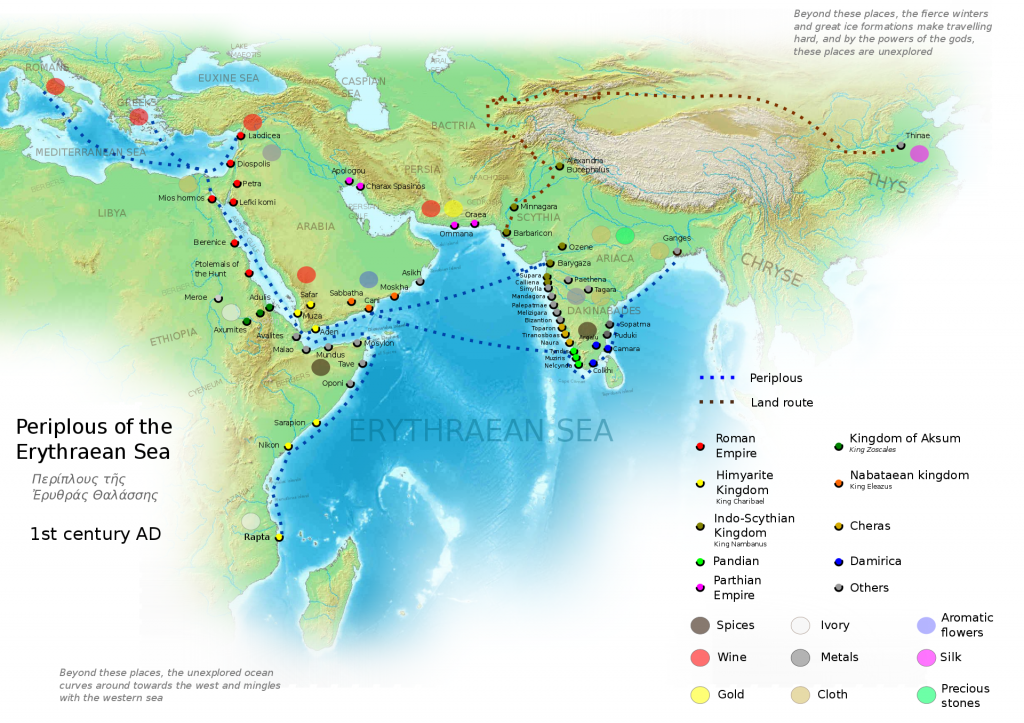
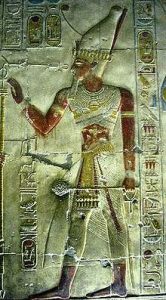

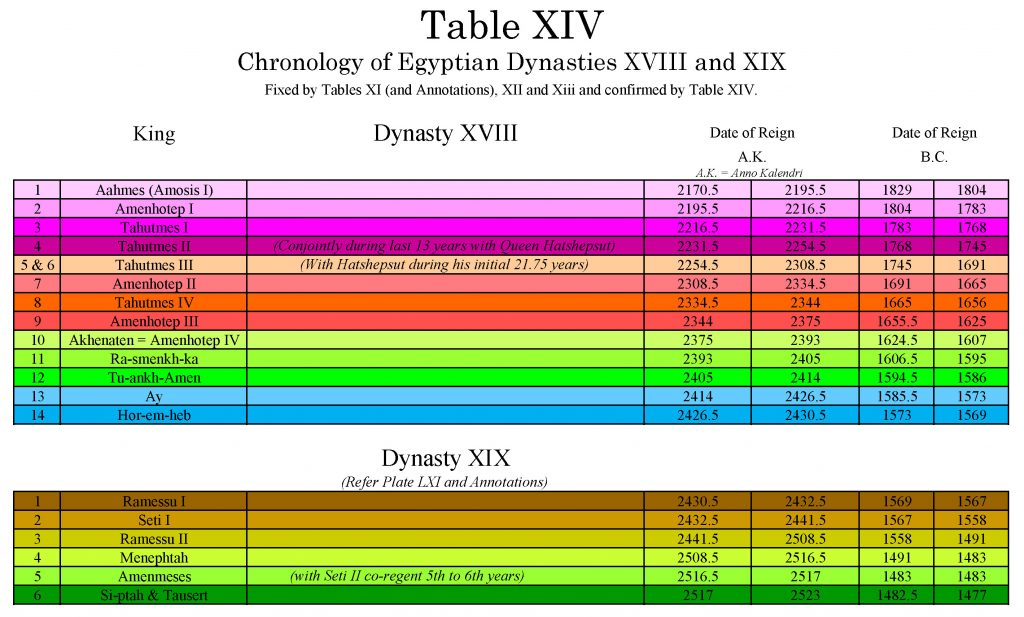
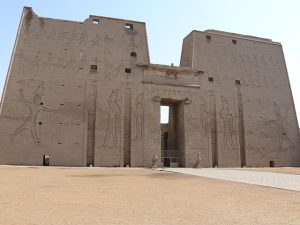
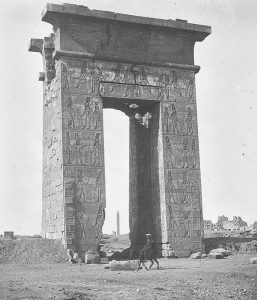



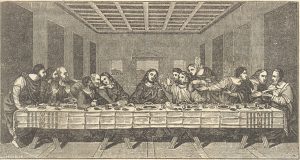 Can you name the Biblical holyday when the following words were spoken?
Can you name the Biblical holyday when the following words were spoken?